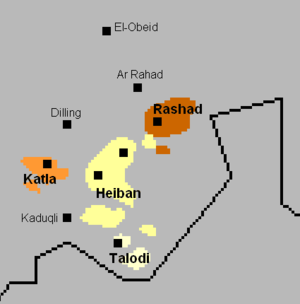Cordovan languages
The Cordofan languages or Kordofan are a group of small language families spoken in the Nuba Mountains in the South Kordofan province of Sudan. The classification of this family is an open problem and its relationship with other Niger-Congo languages still divides experts.
History
The Kordofan languages were very little known, only at the end of the XIX century they began to be systematically studied, before that To date, only two short vocabulary lists had been published for the "takele" (Tegali?) and the "Schabun", compiled by German Africanists. Between 1847 and 1853, Karl Tutschek worked with a native Tumale speaker, Djalo Djondan, who had been freed in the Alexandrian slave market and taken to Germany.
At the end of the XIX century, another list was published for the "tegelé" (Tegalí). The pre-eminence of Tegalí in earlier studies has much to do with the relative importance of the kingdom of Tegalí in the 19th century.
Lepsius (1880) appreciated the importance of the Kordofan languages for the classification of African languages. During the 20th century extensive field work was carried out in the Nuba Mountains. it was had at the beginning of the XX century of these languages. Gradually over the 20th century, the spread of the Kordofan languages, their grammatical features, lexicon, and relationships between they got to know each other better.
Classification
Joseph Greenberg proposed that the Cordophan languages were related to each other and together formed a phylogenetic group distantly related to the Nigero-Congolese languages. According to another classification, they are placed together with the Niger-Congo languages within the Niger-Cordofan language family.
Other authors consider that the Cordovan languages do not constitute a valid phylogenetic unit and in fact several of their subgroups could in fact be related to different from the established families. Currently, the majority consensus does not consider the Kadu languages (kadugli-crongo) as part of the Niger-Congo languages (in fact, some authors place them within the Nilo-Saharan languages). Neither do the rest of the groups seem to form a phylogenetic unit.
List of Kordofan languages
A list of Cordovan languages is as follows:
- Kadugli-krongo languages (Kadu) (73,000 speakers, also calls tumtum or kadu), they were considered as Cordofanas at first, but are currently considered as Nilo-Saharian languages.
- Kadugli (Kaduqli)
- Krongo
- Cordofana languages themselves said:
- Talodi-heiban languages
- Heiban-Koalib
- Fungor (also called ko, kau or nyaro; 2,400 speakers)
- Koalib (also called koalib24,000 speakers)
- Utoro (10,400 speakers)
- Tira (tiro) (10,100 speakers)
- Moro (15,000 speakers)
- Shirumba (also called shwai2,800 speakers)
- Talodi languages (16,500 speakers)
- Talodí (also called) talawdi or jomang)
- Lafofa (also called tegem)
- Daloca (also called ngile)
- Denguebu (also called Maskin)
- Heiban-Koalib
- Katla-rashad languages
- Katla (also called katla; 12000 speakers)
- Kalak (also called katla)
- Lomorik (also called ♪)
- Tegali-tagoi languages (also called Rashad29,000 speakers)
- Tegalí
- Tagoí
- Katla (also called katla; 12000 speakers)
- Talodi-heiban languages
Internal sorting
Kadugli-Krongo languages (Kadu languages) aside, the first-level classification of the Kordofan languages is uncontroversial and consists of four clear phylogenetic groups:
- Heiban Group (koalib; koalib-moro)
- Talodi Group (talodi; talodi-masakin and lafofa)
- Ngile (daloka, masakin)
- Dengebu (reikha, masakin)
- Tocho (moro)
- Jomang (talodi)
- Nding (eliri)
- Tegem (lafofa)
- Rashad Group (tegali; tegali-tagoí)
- Katla Group (Katla)
These names correspond to those of the most important localities of the domain of each of the four linguistic groups. What is not so clear are the internal relations of these four groups. Some authors have proposed two supergroups talodi-heiban and rashad-katla, the second being more dubious than the first. The lexical similarity of these four groups analyzed in the ASJP Comparative Project suggests the following grouping for the above four groups:
| |||||||||||||||||||
Linguistic description
The first known brief grammar of a Kordofan language was written by Meinhof (1943-44), and was a grammatical outline of ebang (also called heiban) based on analysis of two translations of the gospels. The most complete grammar of a Kordofan language is the Moor grammar of Black and Black (1971). Carlo Muratori's notes on the orig (variety of tegali), were reanalyzed and edited by Schadeberg and Elias (1979). And for the Kadugli language group (now considered to be Kordofan), Reh (1985) provided an extensive and detailed description of Krongo.
Lexical comparison
The reconstructed numerals for different branches of the Cordovan languages are:
GLOSA Niger-Congo Nilo-sahariano Talodi-Heiban Katla-Rashad Kadugli-krongo PROTO-TALODI PROTO-HEIBAN PROTO-KATLA PROTO-RASHAD '1' *- munillifiesk *-ad- meant *-t-e devoted- *-t(towards)á * '2' *- *-tan *-kgil(k) *-a memorial '3' *-ambitt-у-k *-e-il *-t-” *-ikt-a *-- tipna '4' *--ḥ *gw-aŋ국 *-g vibral *(w-)a webram *-gi cycles '5' ♪ d--ud-ine ♪ ♫ ♫ *d *um intended '6' *5+1 *--d-fit-il * '7' *5+2 *4+3/
*5+2*5+2 '8' *5+3 *--uuuba(GUE)/
*4x2*dup devoteda '9' *5+4 *5+4 *10-1 '10' ♪ a-ttuḷ *d-ui
Contenido relacionado
Agglutinative tongue
Wikiproject:Languages of the world
Kiñarwanda

